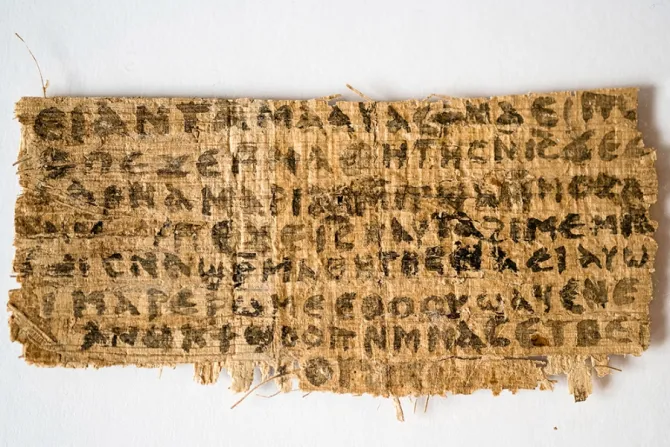Denver, Colo., Sep 20, 2012 / 12:49 pm
A scrap of Egyptian papyrus that might depict Jesus with a wife has drawn media attention, but a scripture professor says it should not affect Christians' understanding of Jesus.
Mark Giszczak, Assistant Professor of Sacred Scripture at the Augustine Institute in Denver, said that those who use sources like the papyrus to continue a controversy over whether Jesus was married are "really seeking to revive the ghost of Dan Brown's 'The Da Vinci Code' novel."
He told CNA Sept. 19 that some of the interest in these sources derives from an "obsession with making Jesus seem like nothing special, a mere human teacher rather than the Son of God."
"Jesus, the incarnate Word, confronts every generation anew with his radical claims to be God and to die for the world," he stated. "The story of his life should not be rewritten, but received and believed in."
The text in question is a fragment of papyrus written in the Egyptian Coptic language. The fragment is about 1.5 inches by 3 inches.
It bears the phrase "Jesus said to them, 'My wife ...'" and on the next line it allegedly says "she will be able to be my disciple."
The origin of the fragment is not known, though it was first examined in the 1980s. It appears to date to the fourth century and likely came from Egypt. Its owner remains anonymous and is trying to sell his collection to Harvard.
Harvard Divinity School historian Karen L. King reported on the fragment in Rome on Sept. 18 at the International Congress of Coptic Studies.
Giszczak said the Catholic Church has never taught that Jesus was married and the New Testament does not say he had a wife.
"A fourth century text that reports that Jesus said 'my wife' does not change what we know about Jesus from the New Testament," he said. "Rather, it shows that certain fourth century Coptic-speakers might have believed that Jesus was married, a belief which contradicts the account of the gospels."
Some Old Testament figures like the prophet Jeremiah and first-century Jews practiced celibacy, while Jesus himself encouraged the practice in Matthew 19, Giszczak noted.
King has consulted with experts who say that the fragment is likely not a forgery. She has suggested that the fragment is copied from a second-century Greek text.
However, other Coptic experts have questioned the fragment's authenticity, according to the Associated Press. They are critical of its appearance, grammar, script, lack of context, and ambiguous origins.
In remarks to The New York Times, King cautioned against using the fragment as proof that Jesus was in fact married. She said the text was likely written centuries after Jesus lived and Christian literature does not say anything about whether Jesus was married.
However, major media sources like The New York Times have said the discovery could "reignite" debate about whether Jesus was married. They also say the fragment could cause debate over whether Jesus may have had a female disciple.
Giszczak rejected this view. He noted that the New Testament shows Jesus had female followers who were with him at the crucifixion, including Mary Magdalene, but no wife is mentioned. Women, including his mother Mary, were also with the apostles after the Ascension.
(Story continues below)
"Jesus clearly had women among his disciples," he said, adding that they were not counted among the12 apostles whom Jesus specially appointed to preach and judge.
Giszczak said Catholics should be "wary" of reputed new discoveries and "wait for all the facts to come out." New texts should be "weighed in light of the New Testament and the teaching of the Church."
Non-canonical documents about Jesus have been a source for sensationalism in the past.
A National Geographic Society investigation on the Gospel of Judas, a second-century text written by a heretical Gnostic sect, resulted in a documentary broadcast on Palm Sunday in 2008.
The project claimed the text showed Judas in a positive light, but prominent scholars accused the documentary of mistranslation, commercial exploitation and scholarly malpractice.



